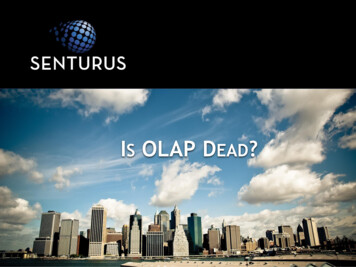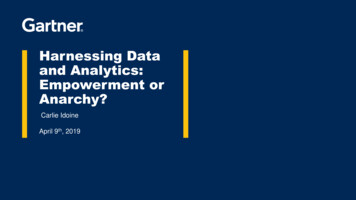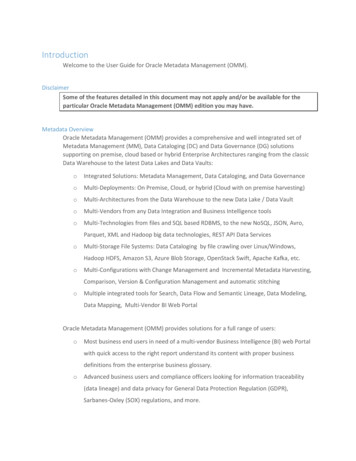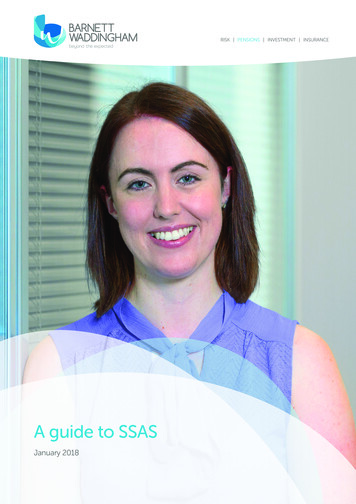
Transcription
RISK PENSIONS INVESTMENT INSURANCEA guide to SSASJanuary 2018
Contents3Introduction4Barnett 13Investments21Drawing benefits33Death benefits39Disclosure2[Insert toGuidetitleSSASof document]
IntroductionA Small Self-Administered Scheme (SSAS) is a particular type of occupational pensionscheme that is often used by business owners as a means of saving for retirement, whilstretaining more control over the use and investment of monies than is usually the case inother types of pension arrangement.A SSAS is often used as a more flexible alternative to a Self-Invested Personal Pension (SIPP), particularly wherethere is likely to be more than one person saving for retirement.A SSAS is a specific form of trust, established by an employer,What makes a SSAS differentfrom other pension schemes?which complies with the requirements of the FinanceIf all members are trustees, they are moreAct 2004 (as amended from time to time) to qualify as ainvolved in the day-to-day administration ofregistered pension scheme. Each SSAS is registered with HMthe pension scheme, which is why SSASs areRevenue & Customs (HMRC) allowing it to have the sametermed ‘self-administered’. ‘Small’ reflects thefavourable tax treatment as any other registered pensionfact that there can be no more than elevenscheme in the UK.members in the SSAS.A SSAS is usually, but does not have to be, set up on aA SSAS may interact with the sponsoringmoney purchase basis. This means that the benefits paidemployer(s) in a number of ways. The trusteesto its members are based on the value of their accruedmay lend money to, lease commercialfunds built up as a result of contributions, transfers in andproperty to, own an asset with, or even owninvestment returns.shares in a sponsoring employer.How is a SSAS structured?One important feature of a SSAS is that its membersshould all be trustees and can direct how theirpension monies are invested, within certain rules.This means that a SSAS has many exemptions frompension legislation applicable to other pension schemesand so permits a greater range of investments and fewerA SSAS is not tied to a particular provider: itis a scheme in its own right and the trusteescan choose where to invest their monies,who will prepare financial statements andhow to operate benefit payments.Who can have a SSAS?administrative requirements than other occupationalA SSAS is set up by an employer, usually for itspension schemes.business owners, directors or key personnel.Although there is no lower or upper age limitfor members, there is a minimum age of 18in order to act as a trustee. An employer mayset up more than one SSAS.Guide to SSAS3
Barnett WaddinghamBarnett Waddingham is proud to be a leading independent UK consultancy at the forefrontof risk, pensions, investment and insurance.We have a team of over 49 SSAS specialists spread overfive offices: Amersham, Cheltenham, Glasgow, Leeds andLiverpool.What does Barnett Waddinghamoffer to SSASs?We offer a wide range of services for SSASs, so you can decidewhat aspects you need us for. We can meet with businessesinterested in setting up a SSAS and their advisers, provide thetrust documentation and other paperwork to establish theSSAS, register it with HMRC, provide a professional trustee toact alongside the member trustees, manage the day-to-dayCan you provide investmentor financial advice?We are not regulated to provide investmentand financial advice to either the trustees orthe members. You may wish to seek yourown investment and financial advice viayour existing financial adviser. Alternativelyyou can find details of advisers local toyou at: www.findanadviser.org. Or you cancontact the Personal Finance Society on020 8530 0852.administration, organise retirement and death benefits andWe are happy to work with otherclose down the SSAS once it has served its purpose.professional advisers to implementWhat are your fees?We generally charge on a time-cost basis, though thereinvestment decisions and strategies.Pension Wiseis a fixed fee for setting up a SSAS and a minimum annualThe government is offering everyone agedfee where we act as professional trustee. These fees are50 and over access to free and impartialreviewed each year in June and the latest fee sheet can beguidance on the choice of retirementdownloaded from our website at www.bwssas.co.uk. Ouroptions available from defined contributioncharges would normally be met by the sponsoring companypensions, via its ‘Pension Wise’ service.but fall upon the SSAS if the company fails to pay, or if thereis no such company. Alternatively, the SSAS can meet thefees from the outset if this is desired.What is your commitment to SSASs?We have been involved in the self-administered pensionsmarket for the whole of our history since 1989 and weremain a strong supporter of such pension arrangements.We continue to manage one of the largest portfolios ofSSASs in the UK.4Guide to SSASYou can find more details of this service at:www.pensionwise.gov.uk or by contactingthem on 0300 330 1001.
AdministrationHow do I set up a SSAS?Trust documentation is required which the employer andinitial trustees will need to sign. We will provide this for youonce you complete the application forms.The trust will need a bank account to receive monies and wecan also help with this.The trust will need to be registered with HMRC beforecontributions or transfers are received. We will arrange thisas part of the set up process.Who can I appoint as trustees?We recommend that all members be appointed as trusteesto be exempt from onerous legal requirements for dealingwith members who are not trustees. Where we areestablishing a scheme, we also require that our professionaltrustee company is a trustee.Whilst this is not a legal requirement, it providescomfort to HMRC and you should benefit fromhaving a trustee who is aware of the specificrequirements that apply to pension trusts andensure that any legislative changes are enactedswiftly and correctly.A short guide to the role of a trustee to assist membertrustees in understanding their requirements can bedownloaded from our website at www.bwssas.co.uk.Guide to SSAS5
What work is involved in running a SSAS?trustees are responsible for dealing with income, expenditureHow do I know what mypension fund is worth?and investment transactions. Further, there are specificThe trustees should ensure thatThe trust finances have to be managed, meaning that thereporting requirements that apply to pension trusts, such asnotifications to members, reports to HMRC and dealing withThe Pensions Regulator (TPR). Our trust company will dealwith compliance and administration whereas the membertrustees will deal with investment decisions.Who would perform the day-to-daymanagement?there are financial statementsprepared every year setting out howmuch the fund is worth in total, andsupplement this by allocating thetotal fund between the members.We can assist with preparation ofunaudited financial statements andallocations between members.The scheme administrator would deal with day-to-dayThe financial statements can take themanagement. The scheme administrator can be any personform of a simple balance sheet, moreor company but it is usual for the trustees to carry out thisformal accounts or even auditedrole, which they may delegate to a managing trustee oraccounts, depending on the trustees’a professional trustee. We act as the day-to-day HMRCrequirements.registered Scheme Administrator for the great majority of ourexisting clients.In between accounting periods,the scheme administrator canWe act as the day-to-day HMRC registeredScheme Administrator for the great majority of ourexisting clients.For all new schemes, or existing scheme takeovers, wewill act as joint Scheme Administrator with the membertrustee(s) and/or sponsoring employer.6Guide to SSAScommission informal updates.
What if my circumstances change?Any member can transfer their assets to another registeredpension scheme or buy an annuity with their share of theSSAS fund, if they no longer want to be part of a SSAS.Members aged 55 or over can also choose to withdraw theirwhole fund, most or all of which will be subject to income tax.The SSAS can be wound up once all members’benefits have been transferred elsewhere orsecured by the purchase of insured annuities.There are costs involved in closing the trust and reporting itsclosure to the various regulatory authorities.Where can I find out more about HMRCrequirements?The government issues guidance on pension schemeadministration rationHMRC’s ‘Pensions Tax Manual’ provides information forscheme members, scheme administrators, sponsoringemployers and more technical details.[Insert title Guideof document]to SSAS7
ContributionsHow much can an employer contribute?There is no specific salary-related limit to how much anemployer can contribute, but the employer will only receivecorporation tax relief on the contributions that are ‘whollyand exclusively for the purpose of the business’ i.e. arejustifiable by reference to what you do for the company.%However, income tax is charged to the member if totalcontributions from all sources exceed the Annual Allowance(AA) (which is 40,000 gross for 2017/18 or 4,000 gross forthose who have flexibly accessed their pension rights).Corporation tax relief is granted by the local HM Inspectorof Taxes and can be spread across two or more tax years incertain situations.What are the limits for personalcontributions?If you are resident in the UK you can usually contribute up to100% of your relevant UK earnings in any one tax year andreceive tax relief provided the contribution, together withany employer contributions, doesn’t exceed the AA.What are relevant UK earnings?For most people, this is employment income taxable in theUK and self-employed income which is chargeable underPart 2 of ITTOIA 2005 (Income Tax (Trading and OtherIncome) Act 2005).8Guide to SSASIncome tax is charged to the memberif total contributions from all sourcesexceed the AA.
Should I make employer or personalcontributions?Employer contributions are paid gross directly from theCan I or my employer makeup for previous years when nocontributions were paid?company and so the gross funds are available immediatelyIf you have been a member of any pensionfor investment and there is no National Insurancescheme during any of the previous threecontributions applicable.tax years and not contributed up to thePersonal contributions can be paid net of basic rate tax, if therelevant AA in those years, you may have anscheme has been registered for ‘Relief at Source’, in whichcase the pension scheme administrator will need to reclaimany basic rate tax relief for which you are eligible fromHMRC. Alternatively, personal contributions can be paidgross, in which case any tax relief would have to be claimedvia self-assessment.For a small scheme such as a SSAS, paying grosspersonal contributions saves the administration ofdealing with ‘Relief at Source’, which is designed forlarger schemes.extra amount which you or your employercan contribute using ‘carry forward’ rules(provided that you have already contributedthe maximum for the current tax year).These rules are complex and you shouldspeak to your financial adviser if you thinkthis may apply to you.If you have ‘flexibly-accessed’ any pensionrights on or after 6 April 2015, you lose anycarry forward of unused allowances as wellas being subject to the Money PurchaseAnnual Allowance (MPAA) as opposed to theWhat if I am a higher rate taxpayer?AA (see page 20).If you are a higher rate taxpayer and only basic rate reliefhas been claimed by the scheme administrator on your netcontribution, you can usually claim the balance of tax relieffrom HMRC through self-assessment.Can contributions be made even thoughI am receiving retirement benefits?Yes, although you cannot fund contributions by using yourretirement lump sum. Personal contributions made after youhave attained age 75 do not attract tax relief.Guide to SSAS9
Can contributions be made for me if I havea form of Lifetime Allowance Protection?Some people have registered with HMRC for protectionagainst the Lifetime Allowance (LTA), which gives themexemption from the LTA Charge if they have EnhancedProtection (EP), or a higher LTA if they have PrimaryProtection (PP), Fixed Protection (FP), Fixed Protection 2014(FP14), Individual Protection 2014 (IP14), Fixed Protection2016 (FP16) or Individual Protection 2016 (IP16). Registrationis closed for all of these, other than FP16 and IP16 for whichthere is no stated deadline.Contributions are only permitted under PP, IP14and IP16: if contributions are made, the higher LTAis still maintained.If you have EP, FP, FP14 or FP16, then the protection will belost if you or your employer pay contributions. You shouldalso not set up a new pension arrangement other than toreceive a transfer from an existing pension arrangement. Thisincludes setting up or varying life cover for your SSAS, (unlessan Excepted Group Life Policy is effected).10Guide to SSAS
Can contributions be paid in-specie inthe form of property or shares?Yes, but you should seek specific advice beforeproceeding. In-specie contributions of this type are onlytax efficient if carefully documented. There are additionalcosts involved with this type of contribution comparedwith making cash contributions.Will my Annual Allowance be subjectto tapering?Possibly. From 6 April 2016 legislation has been introducedto reduce the AA for ‘high earners’. You are defined as aA high earner means ‘adjusted income’in a tax year exceeds 150,000 and‘threshold income’ exceeds 110,000high earner if your ‘adjusted income’ in a tax year exceeds 150,000 and your ‘threshold income’ exceeds 110,000.Where tapering applies, your AA will be reduced by 1for every 2 of adjusted income above 150,000 up to amaximum reduction of 30,000 for those with ‘adjustedincome’ of 210,000 and over in a tax year.Can Barnett Waddingham give me adviceon what contributions to pay?No. We can provide you and your advisers with informationabout contribution rules and allowances, but not what levelof contribution is suitable for you in your circumstances.Guide to SSAS11
TransfersCan I transfer existing pension benefitsinto a SSAS?Can I transfer my existingSSAS to Barnett Waddingham?Yes. Transfers can be received, even if you have drawnOur trustee company could act as thebenefits from the other scheme. If you are in Cappedprofessional trustee to your existing SSAS,Drawdown, there may be a reassessment of your maximumreplacing the incumbent professional trusteepension following transfer and so you should confirm theif there is one.position with your adviser.If you are not drawing benefits you may wish to check withyour adviser whether there are any beneficial rights that youmay lose on transfer, such as guaranteed annuity rates, lifecover or higher lump sums on retirement.There is no tax relief on a transfer from a registered pensionYou could just use us as anauthorised practitioner for thescheme whereby we could provideguidance to the trustees on variousmatters without actually beingappointed as a trustee.scheme and transfers coming from other registered pensionschemes do not count towards the AA.Can I transfer in Protected Rights?Yes. The distinction between Protected Rights and otherpension monies disappeared with effect from 6 April 2012.Can you give me advice on whetherto transfer?No. You may wish to seek your own independent financialadvice via your existing financial adviser. Alternatively youcan find details of advisers local to you at:www.findanadviser.org or you can contact the PersonalFinance Society on 020 8530 0852.Obtaining financial advice in relation to a proposed pensiontransfer is now a legislative requirement for transfer valuesof 30,000 and above from a defined benefit pensionscheme, or any scheme with safeguarded rights (such as aguaranteed annuity rate).12Guide to SSASWhilst this is potentially easier to set up, wedo find that errors (which can result in severetax penalties) are more likely to occur wherethere is no professional trustee.
InvestmentsHow can the SSAS funds be invested?The powers that SSAS trustees have to invest are set outin each individual scheme’s trust deed. This may give thetrustees the power to invest in most assets, but it shouldbe noted that the overriding legislation imposes taxes todiscourage certain investments.This section sets out details of tax efficient investments, whichare known as acceptable investments, and tax inefficientinvestments, known as non-acceptable investments.Can the trustees hold cash?Yes, and in fact a current account will be needed to take careof income and expenditure, to pay benefits and to receivecontributions and transfers.Where we act as professional trustee, we prefer theSSAS to set up a current account with Cater Allen.We have a good working relationship with them and bothwe, the trustees and other scheme advisers have the facilityto view account balances and transactions up to the previousworking day. Also, we do not charge for overseeing the currentaccount, as we receive remuneration directly from the bankrelating to deposits. Full details are provided before you set upthe account. Other bank accounts may be used, though wewill charge for our time for this.Guide to SSAS13
What are the other acceptableinvestment options?What are the non-acceptableinvestments?Acceptable investments include:Direct or indirect investment into the following bank and building society deposit accountsnon-acceptable assets should be avoided: National Savings and Investments residential property stocks and shares tangible moveable property* unquoted shares* loans to any individuals or their relatives commercial property and land loans to connected companies Trustee Investment Plans and bonds investments that are viewed as tradingactivities Executive Pension Plans loans to sponsoring employers* loans to unconnected companies hedge funds unit trusts / OEICS* Tangible moveable property includes: vintage cars and yachts plant and machinery works of art, stamps, antiques, fine wine investment grade gold bullion traded options** financial and commodity futures** copyrightsGround rents relating to residential propertyare treated as residential property.Residential property and tangible moveableproperty are classified as ‘taxable property’Investments can be made in the UK and, in principle,and are subject to tax charges. More detailsoverseas, and can be made jointly with other investors ifare given overleaf.need be.Tax charges may also arise if loans are madeYour SSAS can buy or sell assets from/to you, your familyto sponsoring employers that do not qualifyor your business, provided the transaction takes place atas authorised employer loans, or if the SSASmarket value.uses too much of its funds to purchaseWhilst a scheme can hold an interest in a propertyinvestment LLP, income and capital gains are subject toincome tax and capital gains tax respectively.* subject to certain limits and criteria, detailed overleaf** provided the maximum loss is limited14Guide to SSASshares in sponsoring employers.
What are the criteria for an employer loan?repayment terms.What are the limits onbuying shares in thesponsoring employer(s)?Total employer loans cannot exceed 50% of the netThe SSAS can invest up to 5% ofassets of the SSAS at the time advances are made. Loansits net assets in shares of eachmust be secured throughout by a first charge over thesponsoring employer and can investsecurity of adequate value. The interest rate must be ano more than 20% of its net assets inminimum of 1% over base rate, although during periods ofsuch shares in total.An authorised employer loan has to satisfy certain keycriteria in relation to amount, security, interest rate, term, andlow interest rates, a higher rate might be viewed as morecommercially appropriate.The term of an authorised employer loan shouldbe no more than five years, and can only beextended once if the borrower is experiencinggenuine financial difficulties, in which casedividends should not be paid in preference toservicing a loan.The shares will need to bepurchased at a price backed up byan independent valuation – whichcould be prepared by the company’sauditor, but not by the company’sin-house accountant.An authorised employer loan must be repaid in equalinstalments of capital and interest for each complete yearof the loan. Failure to adhere to these terms could incur taxpenalties for the SSAS and the borrower.Guide to SSAS15
Can the trustees borrow money to fundinvestments?What are the rules for leasingpremises to my company?Yes. The trustees can borrow from any commercial lenderThe lease terms would have to reflectof their choice (or from the employer or a SSAS membercommercial terms available in the market andprovided that this is done on ‘arm’s length’ terms).this requires an independent rental valuationThe maximum borrowing (including any existing borrowing)must not exceed 50% of the net value of the SSAS each timeany borrowing takes place.What are the rules for buying thepremises owned by my company?The transaction would have to happen at market value asthough it were an arm’s length transaction, and would gothrough a proper conveyance. The usual Stamp Duty LandTax and VAT considerations would apply. To demonstratethe market value, there should be an independent propertyvaluation supporting the transaction price, undertaken by aprofessionally qualified surveyor.16Guide to SSASsupporting the annual rent and term of thelease.What is an indirect holding oftaxable property?If a SSAS holds an interest in an entity, suchas owning share capital of a company,which itself owns taxable property, then theSSAS is treated as owning the whole or partof that taxable property.
What are the consequences of investingin taxable property?If a SSAS is holding taxable property, either directly orindirectly, then there are tax charges on the purchase price, tax charges on the income (or deemed income) and taxcharges on the capital gains.These tax charges outweigh the benefits of getting taxrelief on contributions to pension schemes and thereforeownership of taxable property should be avoided.Are there any exemptions of indirectholdings of taxable property?Indirect investments held through ‘genuinely diverseIndirect investments held through‘genuinely diverse commercial vehicles’will not be subject to tax charges whenheld as a SSAS investment.commercial vehicles’ will not be subject to tax charges whenheld as a SSAS investment. HMRC lists three categoriesof genuinely diverse commercial vehicle: UK Real EstateInvestment Trusts (REITS), Trading Concerns and ‘other kindsof vehicle’. Specific conditions still need to be met and sospecialist advice should be taken.What if I have an existing SSAS whichalready holds taxable property?Transitional protection may be available in certaincircumstances for holdings owned by a SSAS prior to 6April 2006, but will be lost if, for example, that taxableproperty is added to or improved, or transferred to adifferent pension scheme.Guide to SSAS17
Can I use assets owned by the SSAS formy personal use?No. As most assets that might be suitable for personal usequalify as taxable property (e.g. holiday homes and cars), it isunlikely that this opportunity will occur.What is meant by residential property?HMRC sets out that residential property can be in the UK orelsewhere and is: a building or structure that is used or suitable for use as adwelling; any related land that is wholly or partly the garden for thebuilding or structure; any related land that is wholly or partly grounds for theresidential property and which is used or intended foruse for a purpose connected with the enjoyment of thebuilding; any building or structure on any such related land; in limited situations a hotel, which includes an inn, orsimilar accommodation, will be counted as taxableproperty though this will usually only be where it providesaccommodation rights such as timeshare; and a beach hut.18[Insert toGuidetitleSSASof document]
Are there any exemptions as to what isresidential property?What is ‘job-related’accommodation?HMRC has clarified that a building used for any of theThere are two categories of ‘job-related’following purposes is not residential property:accommodation. a dedicated children’s home or other institutionThe property is (or, if unoccupied, is to be)providing residential accommodation for children;occupied by an employee who: a hall of residence (not flats) for students; a home or other institution providing residentialaccommodation with personal care for persons byreason of old age, disability, past or present dependenceon alcohol or drugs or past or present mental disorder; a hospital or hospice; and a prison or similar establishment.If a building is not currently in use and was last used forone of the non-residential purposes set out above, it is nottreated as residential property. If the building has never beennor connected with such a member, is not connected with the employer, and is required as a condition of theiremployment to occupy the property.An example is a caretaker’s flat.Secondly, the property is (or, if unoccupied,is to be): occupied by a person who is neithera member of the pension scheme norused and is more suitable for one of the uses specified aboveconnected with such a member, andthan for any other purpose it is not treated as residentialproperty regardless of its suitability for use as a dwelling.is neither a member of the pension scheme used in connection with businessCertain ‘job-related’ accommodation will not be treated aspremises held as an investment of theresidential property.pension scheme.An example is a pub with the landlord livingabove.Guide to SSAS19
How do the trustees arrange forinvestments to be made?The member trustees select the investments and liaise withHow are the investmentscashed in to pay benefits, feesor other costs?the investment provider (or their investment adviser) to obtainThe member trustees should giveappropriate investment forms for a trust to invest. Theseinstructions to sell investments, whichforms should be completed and sent to the professionalwould be countersigned by the professionaltrustee (if applicable) for verification, and countersignature.trustee (if applicable).Are there any penalty tax charges relatingto investments?Yes, if an unauthorised payment is made, (for example, ifthere is excessive borrowing, if investment transactions arenot carried out at market rate, or if rent is not paid when dueCan Barnett Waddinghamgive the trustees adviceon investments?by a connected tenant). Where we are professional trustee,No. You may wish to seek your ownwe minimise the possibility of an unauthorised paymentindependent financial advice via yourbeing made by becoming a mandatory co-signatory on theexisting financial adviser. Alternativelypension scheme bank account.you can find details of advisers localThe scheme administrator must report all unauthorisedpayments to HMRC and the tax charge on you personally/your company would usually be 40% (or 55% in excessivecases) of the unauthorised payment, and your schemewould also be subject to a further minimum tax charge of15% of the unauthorised payment.Are there any other general investmentpoints to be aware of?Pension schemes could be subject to tax on trading profitswhere HMRC deems the pension scheme to be trading.There is no definition of what constitutes trading, butinvesting the fund in such a way that the fund is operating asan investment company might incite this.20Guide to SSASto you at: www.findanadviser.org oryou can contact the Personal FinanceSociety on 020 8530 0852.
Drawing BenefitsWhen can I take benefits?You can start to take benefits from age 55. If you are inserious ill health, or in a recognised qualifying occupation,or have a protected pension age, you may be able to takebenefits earlier.How are my benefits calculated?Your benefits are based on the value of your share of thescheme assets at your benefit date, as agreed between youand the trustees.What is the maximum amount of benefitI could have?There is no limit on the overall value of your apportionmentIf the total value of all your registeredpension schemes exceeds the LTA,which is 1 million for the 2017/18 taxyear, then a tax charge may apply onthe excess amount above the LTA.within the SSAS. However, if the total value of all yourregistered pension schemes exceeds the LTA, which is 1million for the 2017/18 tax year, then a tax charge mayapply on the excess amount above the LTA. Your LTA maybe different if you have a form of LTA protection, evidencedby a certificate or reference number issued by HMRC (forexample, Fixed Protection).Guide to SSAS21
What is the Lifetime Allowance?Can I have a tax-free lump sum?The LTA is the total amount you can save into pensions inThis is now known as a ‘pensionyour lifetime while still getting tax relief. As stated above, thecommencement lump sum’. You will usuallystandard LTA is 1 million for the 2017/18 tax year.be able to take up to 25% of your schemeIf you go over the LTA you will pay a tax charge on theexcess when you draw out your savings as cash or pension.entitlement (or 25% of your available LTA, iflower) as a pension commencement lumpsum, which is tax-free. There may be a taxYour SSAS entitlement will be assessed against the relevantcharge levied by HMRC if you ‘recycle’ thisLTA when you take benefits, and again when you buy anlump sum to increase your normal pensionannuity, or reach age 75. Each time you take new benefits acontributions.portion of your LTA is used up.Where you exceed the LTA you pay tax on theexcess amount called the
registered pension scheme. Each SSAS is registered with HM Revenue & Customs (HMRC) allowing it to have the same favourable tax treatment as any other registered pension scheme in the UK. A SSAS is usually, but does not have to be, set up on a money purchase basis. This means that the benefits paid


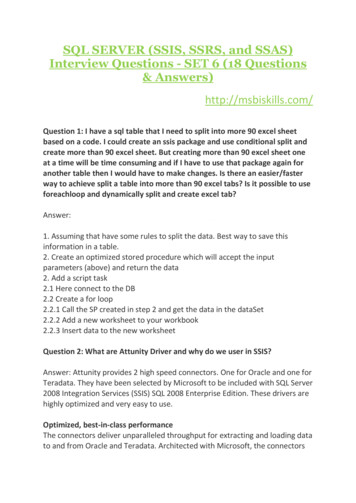
![[MS-SSAS-T]: SQL Server Analysis Services Tabular Protocol](/img/17/5bms-ssas-t-5d-200622.jpg)


![[MS-SSAS-T]: SQL Server Analysis Services Tabular](/img/37/ms-ssas-t-160714.jpg)
